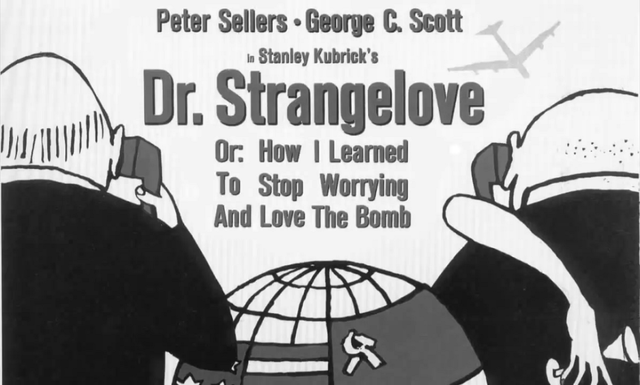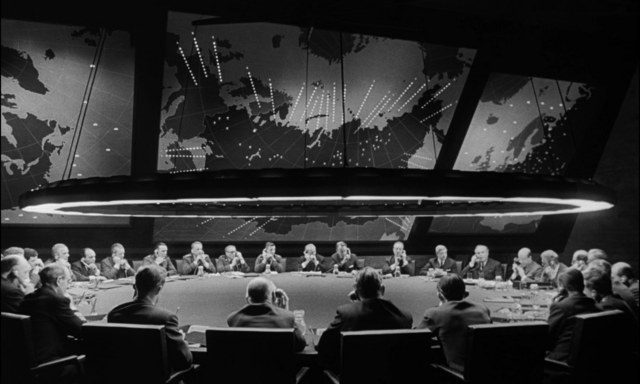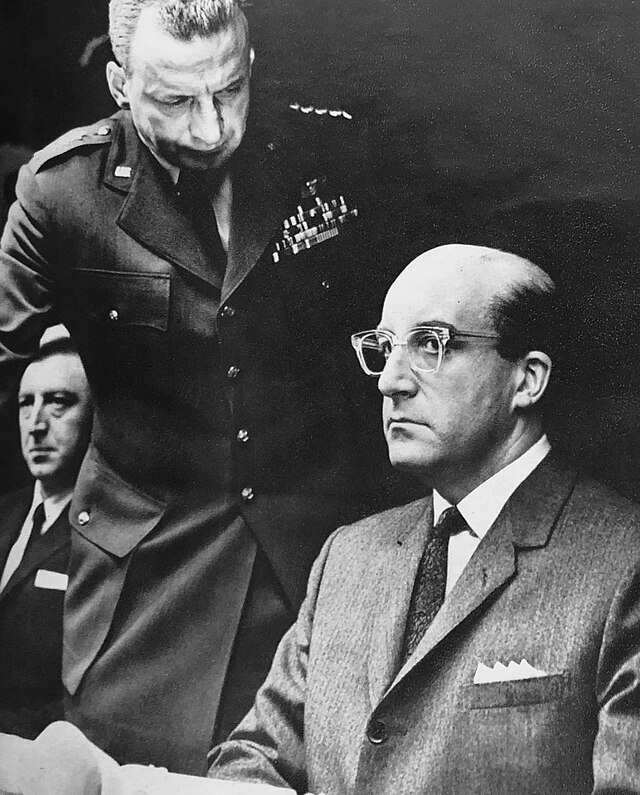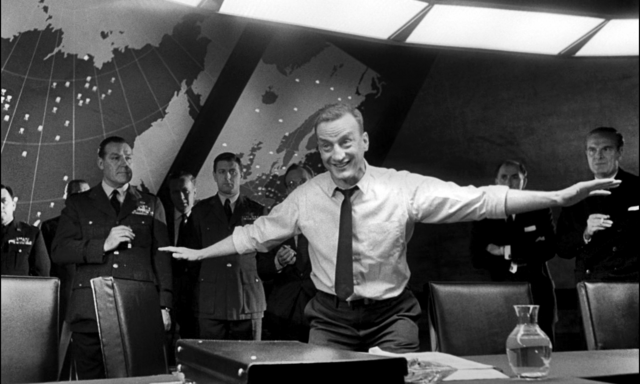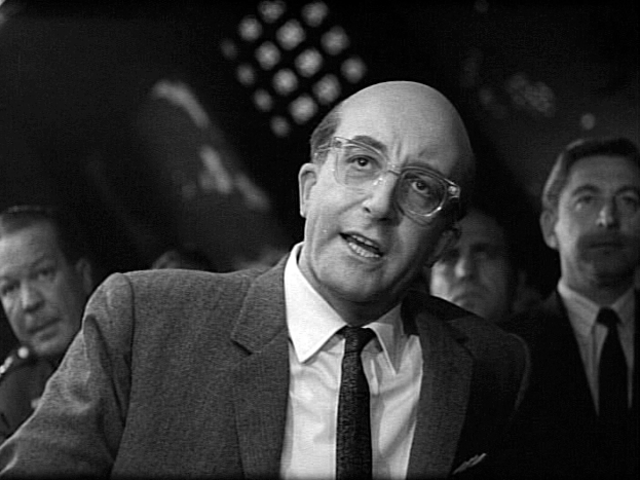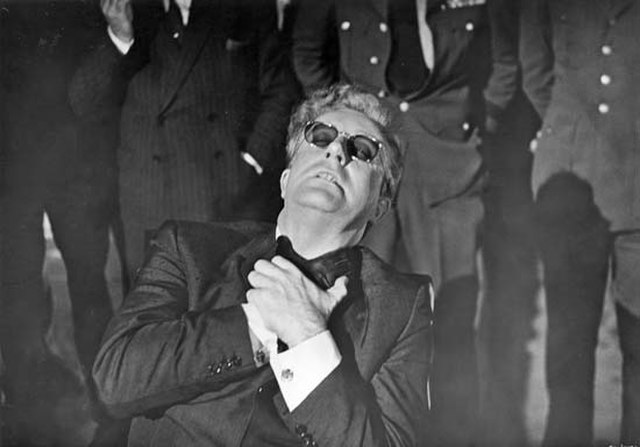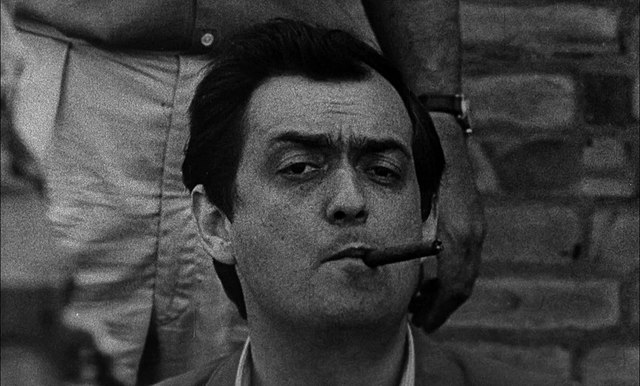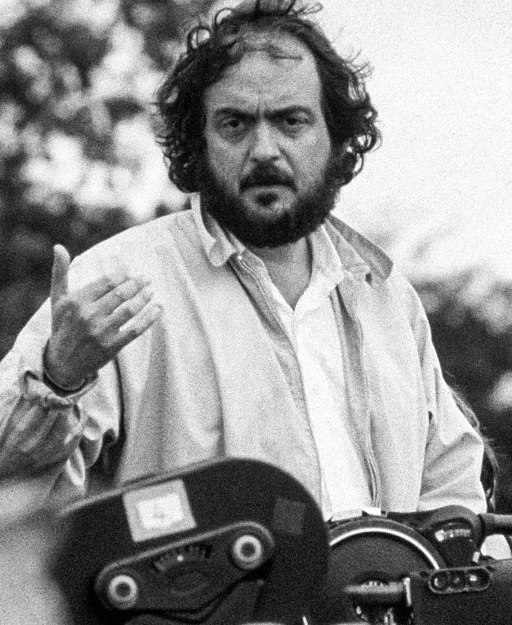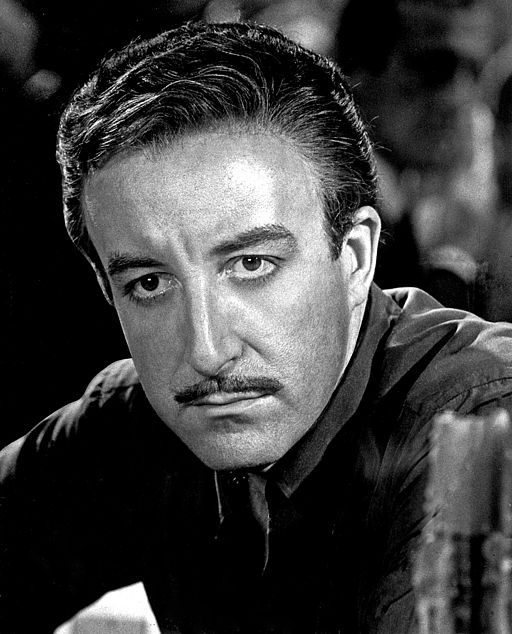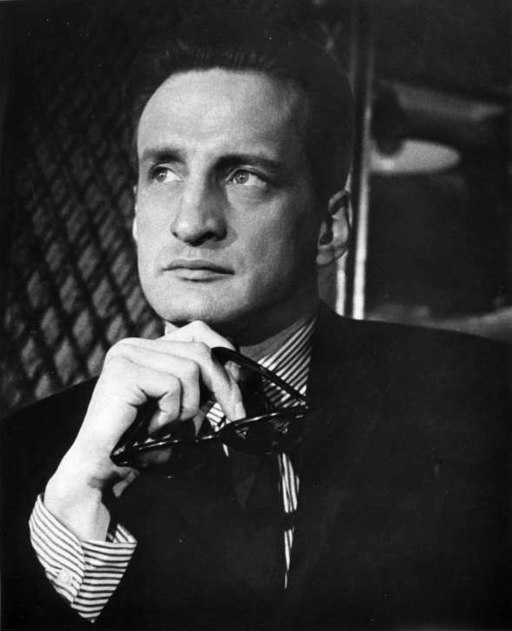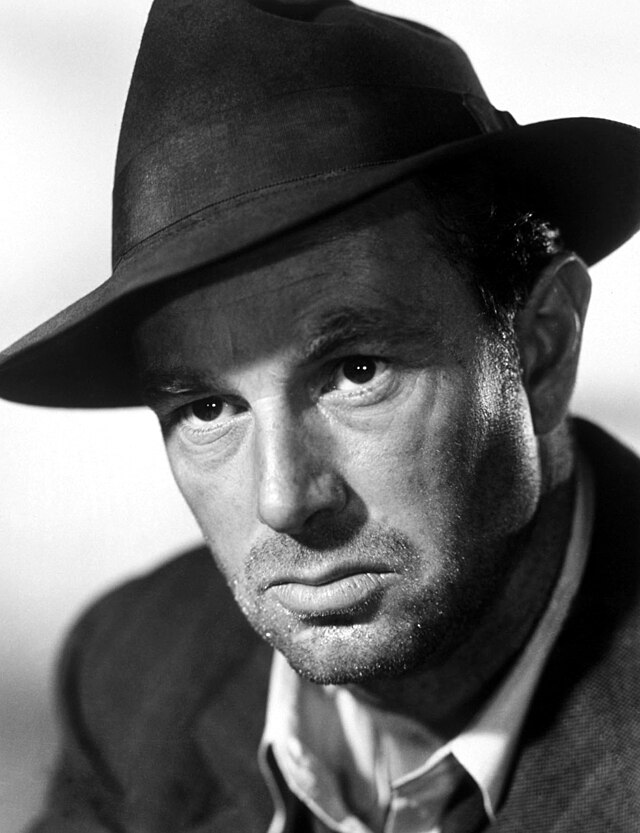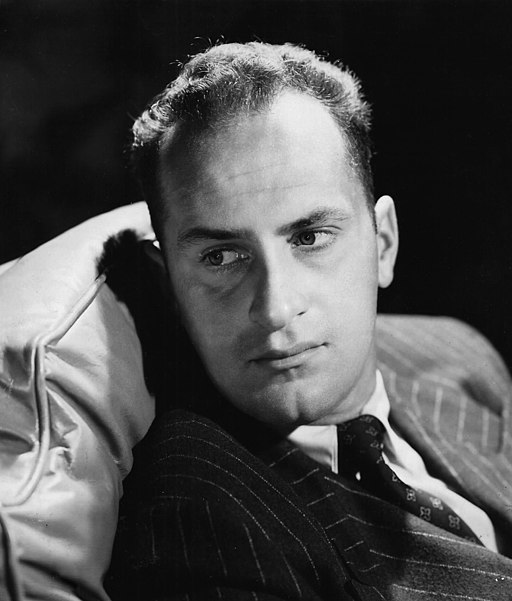Dr. Strangelove -1964
back| Released by | Columbia Pictures |
| Director | Stanley Kubrick |
| Producer | Stanley Kubrick |
| Script | Screenplay by Stanley Kubrick, Terry Southern, and Peter George - Based on the book Red Alert by Peter George |
| Cinematography | Gilbert Taylor |
| Music by | Score composed by Laurie Johnson - |
| Running time | 95 minutes |
| Film budget | $1.8 million |
| Box office sales | $9.4 million |
| Main cast | Peter Sellers - George C. Scott - Sterling Hayden - Keenan Wynn - Peter Bull |
Dr. Strangelove or: How I Learned to Stop Worrying and Love the Bomb
A Darkly Satire that Brilliantly exposes the Absurdity of Nuclear Brinkmanship
Dr. Strangelove is a satirical black comedy that explores the absurdities and potential consequences of nuclear war, driven by a plot involving the accidental triggering of a doomsday scenario. The film is noted for its sharp wit, biting humor, and iconic performances, particularly Peter Sellers' multiple roles. It remains one of Kubrick's most celebrated films and a significant work in both the comedy and political satire genres.
Related
Dr. Strangelove or: How I Learned to Stop Worrying and Love the Bomb – 1964
Summary and Analysis
Dr. Strangelove is a dark comedy set during the height of the Cold War, focusing on the absurdity and dangers of nuclear conflict between the United States and the Soviet Union. The film begins with Brigadier General Jack D. Ripper, a paranoid and deranged U.S. Air Force officer, who unilaterally decides to launch a nuclear attack on the Soviet Union. Believing that the Soviets have contaminated the American water supply with fluoride in a plot to weaken the country, Ripper sends a squadron of B-52 bombers to deliver nuclear bombs to various targets in the Soviet Union.
The U.S. government, unaware of Ripper's actions, scrambles to deal with the crisis. President Merkin Muffley, portrayed by Peter Sellers, convenes a meeting in the Pentagon's War Room with his top military and political advisors, including the hawkish General Buck Turgidson (played by George C. Scott). In an attempt to avert global disaster, Muffley contacts the Soviet Premier to inform him of the rogue attack and promises to assist in stopping the bombers.
Meanwhile, Group Captain Lionel Mandrake, a British RAF officer stationed at Burpelson Air Force Base (where Ripper is in command), becomes the key to understanding Ripper's motivations and potentially stopping the attack. Mandrake, also played by Peter Sellers, discovers that Ripper has taken steps to prevent anyone from recalling the bombers by sealing the base and withholding the recall code.
As the narrative unfolds in the War Room, the American and Soviet leaders struggle to maintain control over the situation. They learn that the Soviets have a doomsday device—a machine designed to automatically trigger a nuclear apocalypse if the USSR is attacked, ensuring mutual destruction. This machine, which was kept secret by the Soviets, cannot be deactivated once triggered, thereby making the situation all the more dire.
In a separate plotline, one of the B-52 bombers, piloted by the gung-ho Major T.J. "King" Kong (played by Slim Pickens), encounters various technical problems but remains on course to deliver its payload. Despite the frantic efforts of the U.S. and Soviet officials, this bomber manages to slip through the defense lines and eventually drops its nuclear bomb.
The film’s climax occurs in the War Room, where Dr. Strangelove (also portrayed by Peter Sellers), a former Nazi scientist now advising the U.S. government, proposes an absurdly macabre plan for human survival: creating underground bunkers where a select group of people could survive the nuclear holocaust and eventually repopulate the Earth. As the doomsday device is activated, the film concludes with a montage of nuclear explosions set to the song "We'll Meet Again" by Vera Lynn, suggesting the end of the world as we know it.
Dr. Strangelove is widely regarded as one of the greatest satires in film history. Through its dark humor and exaggerated characters, the movie critiques the Cold War mentality, the absurdity of mutually assured destruction (MAD), and the dehumanizing effects of technological warfare.
Themes and Satire:
The film’s central theme revolves around the concept of MAD, a doctrine that suggested that full-scale use of nuclear weapons by opposing sides would result in the complete annihilation of both the attacker and the defender. Kubrick highlights the irrationality of this doctrine through the character of General Ripper, whose unhinged actions stem from an irrational fear, and through the character of Dr. Strangelove, who embodies the dangerous combination of technological prowess and moral detachment.
The portrayal of the War Room, a place where the fate of the world is decided, further underscores the absurdity of the Cold War’s brinkmanship. The room is filled with powerful men who, despite their authority, are unable to control the situation they have created. President Muffley, a parody of the rational but ineffectual leader, struggles to maintain composure, while General Turgidson's hawkishness and zealotry highlight the reckless attitudes prevalent among military leaders of the time.
Dr. Strangelove himself, with his bizarre mix of former Nazi ideology and Cold War paranoia, serves as a chilling reminder of how the pursuit of technological advancement and military superiority can override basic human ethics. His infamous line, "Mein Führer! I can walk!" as he momentarily breaks free from his wheelchair, symbolizes the lingering and destructive influence of fascist ideologies within the corridors of power.
Characterization and Performances:
The performances, especially by Peter Sellers in his triple role, are pivotal to the film's success. Sellers' portrayal of three distinct characters—President Muffley, Group Captain Mandrake, and Dr. Strangelove—showcases his versatility and adds layers of comedic and dramatic depth to the narrative. Each character represents a different aspect of the Western response to the Cold War: Muffley as the ineffectual but well-meaning leader, Mandrake as the voice of reason trapped in an impossible situation, and Strangelove as the embodiment of the mad scientist trope, detached from the consequences of his actions.
George C. Scott's portrayal of General Turgidson is another standout, as his exaggerated, almost childlike enthusiasm for war and destruction serves as a biting commentary on military bravado. Slim Pickens’ Major Kong, with his cowboy persona, epitomizes the reckless abandon with which the machinery of war can operate, especially when divorced from the consequences of its actions.
Cinematic Techniques:
Kubrick’s direction and the film’s cinematography by Gilbert Taylor contribute significantly to its tone and impact. The stark black-and-white visuals lend a documentary-like realism to the absurdity on screen, heightening the film's satirical edge. The War Room set, designed by Ken Adam, with its imposing round table and large overhead map, creates an atmosphere of tension and impending doom, contrasting sharply with the ridiculousness of the dialogue and the characters' actions.
The use of music, particularly the juxtaposition of Vera Lynn’s hopeful "We'll Meet Again" with images of nuclear explosions, reinforces the film’s theme of inevitable destruction brought on by human folly.
Legacy and Impact:
Dr. Strangelove has had a profound influence on both cinema and public discourse about nuclear war. Its sharp satire has made it a cultural touchstone, referenced in discussions about the dangers of nuclear proliferation and the risks inherent in military escalation. The film's ability to make audiences laugh while confronting them with the terrifying realities of global conflict ensures its continued relevance.
Kubrick’s film not only serves as a critique of Cold War policies but also as a timeless warning about the dangers of unchecked power and the potential for technology to outpace human wisdom. Its blend of humor, horror, and political commentary makes Dr. Strangelove a masterclass in filmmaking and a poignant exploration of humanity’s capacity for self-destruction.
Classic Trailer of Dr. Strangelove:
Full Cast of Dr. Strangelove:
Main Cast:
- Peter Sellers as:
- Group Captain Lionel Mandrake
- President Merkin Muffley
- Dr. Strangelove
- George C. Scott as General Buck Turgidson
- Sterling Hayden as Brigadier General Jack D. Ripper
- Keenan Wynn as Colonel "Bat" Guano
- Slim Pickens as Major T.J. "King" Kong
- Peter Bull as Soviet Ambassador Alexei de Sadesky
Supporting Cast:
- James Earl Jones as Lt. Lothar Zogg (Bombardier on Major Kong's B-52)
- Tracy Reed as Miss Scott (General Turgidson's secretary and mistress)
- Jack Creley as Mr. Staines (presidential advisor)
- Frank Berry as Lt. H.R. Dietrich (crew member on Major Kong's B-52)
- Robert O'Neil as Adm. Randolph (Chief of Naval Operations)
- Glenn Beck as Lt. W.D. Kivel (crew member on Major Kong's B-52)
- Roy Stephens as Frank (crew member on Major Kong's B-52)
- Shane Rimmer as Capt. "Ace" Owens (B-52 co-pilot)
Uncredited Appearances:
- Gordon Tanner as General Faceman (Chief of Staff)
- John McCarthy as Air Force General
- Hal Galili as Burpelson AFB Defense Commander
- Laurence Herder as Lt. Groves
- Robert Robertson as Gen. Jack Ripper's Aide
- Paul Tamarin as Burpelson AFB Defense Guard
Masterful Direction of Stanley Kubrick:
Stanley Kubrick's direction in Dr. Strangelove or: How I Learned to Stop Worrying and Love the Bomb is a masterclass in blending dark comedy with profound social commentary, showcasing his meticulous attention to detail, innovative storytelling techniques, and unique ability to elicit powerful performances from his actors.
Tone and Satire:
Kubrick’s most striking achievement in Dr. Strangelove is his ability to maintain a consistent tone of absurdity and dark humor throughout the film, despite the grave subject matter. The film deals with the potential end of humanity through nuclear war, yet Kubrick transforms this terrifying scenario into a biting satire that exposes the absurdity of the Cold War mentality. This is achieved by exaggerating the characters’ traits and situations to the point of surrealism, while still grounding them in a reality that feels all too plausible. Kubrick’s direction ensures that the audience is simultaneously amused and horrified, recognizing the ridiculousness of the situation while also feeling the underlying tension and threat.
Visual Style and Cinematography:
Kubrick’s visual style in Dr. Strangelove is both stark and expressive, employing black-and-white cinematography that enhances the film’s documentary-like feel, reminiscent of newsreel footage from the era. The use of deep focus and wide-angle lenses, particularly in the War Room scenes, creates a sense of spatial depth and places the characters within the grand, almost theatrical setting. The War Room itself, with its iconic circular table and oversized world map, becomes a visual metaphor for the power dynamics and looming global catastrophe. Kubrick’s choice of lighting, often casting harsh shadows, further accentuates the paranoia and intensity of the characters’ actions.
Characterization and Performances:
Kubrick’s direction of the actors, especially Peter Sellers, is a key element in the film’s success. By casting Sellers in multiple roles, Kubrick highlights the multifaceted nature of the Cold War tensions, where diplomacy, military strategy, and scientific hubris collide. Sellers' performances are deliberately exaggerated, yet carefully controlled, embodying the absurdities of the characters he plays. Kubrick encouraged improvisation, particularly from Sellers, allowing for moments of spontaneous humor that feel natural within the film’s heightened reality.
George C. Scott’s portrayal of General Buck Turgidson, under Kubrick’s direction, is another example of how the director used performance to enhance the film’s satirical edge. Scott’s over-the-top, almost cartoonish enthusiasm for nuclear war is both comical and unsettling, a reflection of the reckless military attitudes that Kubrick sought to critique. Kubrick famously tricked Scott into delivering his most exaggerated performance by telling him they were rehearsing when, in fact, he was filming the final takes. This technique resulted in a portrayal that is both energetic and unnervingly authentic.
Pacing and Structure:
Kubrick’s control over the film’s pacing is meticulous. Dr. Strangelove is tightly edited, with a running time of just 95 minutes, ensuring that the narrative moves swiftly without losing focus. The film’s structure intercuts between three main settings: the War Room, General Ripper’s office, and the B-52 bomber. This cross-cutting not only builds tension as the crisis escalates but also juxtaposes the different perspectives on the unfolding disaster. Kubrick’s decision to avoid traditional heroism or clear resolutions in the narrative reinforces the film’s bleak outlook on the world’s fate, aligning perfectly with its satirical tone.
Use of Music and Sound:
Kubrick’s use of music in Dr. Strangelove is another example of his directorial genius. The soundtrack is sparse, with most of the film’s tension derived from the dialogue and sound design. However, the use of "We'll Meet Again" by Vera Lynn over the closing montage of nuclear explosions is a stroke of ironic brilliance. The song, a World War II-era anthem of hope and resilience, is here recontextualized to underscore the finality and futility of nuclear war, creating a haunting contrast between the cheerful lyrics and the images of global destruction.
Themes and Message:
Kubrick’s direction ensures that Dr. Strangelove is not just a comedy but a profound commentary on the dangers of nuclear brinkmanship, the fallibility of human institutions, and the absurdity of war. Through his direction, Kubrick makes it clear that the true villains are not just individuals like General Ripper, but the systems and ideologies that allow such individuals to wield power. The film’s ending, with the activation of the doomsday device, is a bleak statement on the inevitability of destruction when such weapons exist—a theme that Kubrick conveys with both subtlety and impact.
Kubrick’s direction in Dr. Strangelove has left an indelible mark on cinema, influencing countless filmmakers and films that followed. His ability to balance humor with serious social critique has set a benchmark for satirical filmmaking. The film’s visual and thematic elements have been widely referenced and parodied, testifying to Kubrick’s lasting impact on popular culture.
In conclusion, Stanley Kubrick’s direction in Dr. Strangelove is a tour de force of cinematic artistry. By combining sharp satire, innovative visuals, and powerful performances, Kubrick created a film that is both entertaining and deeply thought-provoking. His direction not only captures the absurdity of the Cold War era but also offers a timeless reflection on the perils of human folly, making Dr. Strangelove a classic that resonates with audiences even decades after its release.
Comedic Tour de Force of Peter Sellers:
Peter Sellers’ performance in Dr. Strangelove or: How I Learned to Stop Worrying and Love the Bomb is a tour de force of comedic acting, demonstrating his extraordinary versatility and ability to inhabit multiple distinct characters within a single film. Sellers plays three key roles in the movie: Group Captain Lionel Mandrake, President Merkin Muffley, and Dr. Strangelove. Each character showcases a different aspect of Sellers' range, contributing significantly to the film's satirical tone and overall impact.
Group Captain Lionel Mandrake: The Voice of Reason
As Group Captain Lionel Mandrake, a British RAF officer stationed at Burpelson Air Force Base, Sellers delivers a performance rooted in understated humor and subtle anxiety. Mandrake is a quintessentially British character, polite and reserved, caught in a situation that spirals out of control. Sellers portrays him with a gentle bewilderment and an increasingly desperate need to maintain decorum amidst the chaos. His interactions with General Jack D. Ripper, played by Sterling Hayden, are laced with a nervous tension, as Mandrake slowly realizes the magnitude of the crisis at hand.
Sellers’ portrayal of Mandrake is marked by his ability to convey the character's inner turmoil through small, controlled gestures and a calm demeanor that gradually gives way to frantic concern. The contrast between Mandrake’s polite, almost timid nature and the madness surrounding him highlights the absurdity of the situation, making his performance both comedic and sympathetic. Sellers’ subtle shifts in facial expressions and tone as Mandrake tries to reason with the increasingly erratic Ripper add layers to the character, making him a grounded, relatable figure in the midst of the film’s more outlandish personalities.
President Merkin Muffley: The Ineffectual Leader
In the role of President Merkin Muffley, Sellers takes on a completely different persona—an earnest, well-meaning, but somewhat ineffectual leader. Muffley is the straight man in the farcical chaos of the War Room, and Sellers plays him with a measured calmness that contrasts sharply with the hysteria of those around him. His portrayal of Muffley as a somewhat frail, bespectacled, and nervous man adds to the comedic effect, as he attempts to manage the crisis with diplomatic tact and reasoned, albeit increasingly desperate, phone calls to the Soviet Premier.
One of the most memorable aspects of Sellers’ performance as Muffley is his dry, deadpan delivery. The character’s attempts to remain calm and composed while dealing with the impending nuclear disaster are both absurd and poignant. Sellers infuses Muffley with a certain vulnerability, making him a figure of both pity and ridicule. His iconic line, “Gentlemen, you can’t fight in here! This is the War Room!” epitomizes the character's futile attempts to impose order on a situation that has already spiraled beyond control. Sellers’ ability to maintain a straight face in the midst of such absurdity enhances the satirical tone of the film and underscores the ineffectiveness of political leaders in the face of catastrophic decisions.
Dr. Strangelove: The Embodiment of Madness
Perhaps the most iconic of Sellers’ three roles is that of Dr. Strangelove, the eccentric and sinister former Nazi scientist who now advises the U.S. government. Dr. Strangelove is a grotesque caricature, a blend of Germanic precision and barely concealed psychosis, and Sellers’ portrayal of him is nothing short of brilliant. With his slicked-back hair, dark glasses, and gloved hand that seems to have a mind of its own, Sellers creates a character that is both unsettling and darkly humorous.
Sellers’ physical performance as Dr. Strangelove is a masterclass in controlled absurdity. The character’s involuntary Nazi salutes and his struggle to control his errant hand, which repeatedly tries to give a "Heil Hitler" gesture, are both disturbing and hilarious. Sellers plays Strangelove with a mix of glee and malevolence, his voice slipping into a guttural German accent that adds to the character’s menacing presence. The character's monologue in the War Room, where he outlines his bizarre plan for post-apocalyptic survival, is delivered with a mixture of enthusiasm and cold detachment that makes Strangelove both fascinating and terrifying.
Sellers’ portrayal of Dr. Strangelove captures the essence of the character as a personification of the dangers of unchecked scientific ambition and the lingering influence of fascist ideologies. The character's maniacal outbursts, coupled with his calm discussions of horrifying scenarios, highlight the film's central theme of the madness inherent in nuclear strategy. Sellers' ability to oscillate between control and chaos within a single character is a testament to his skill as an actor and contributes significantly to the film's enduring impact.
Versatility and Impact:
The fact that Sellers plays three such distinct characters in Dr. Strangelove is a testament to his versatility as an actor. Each character is fully realized and distinct, showcasing different facets of Sellers’ comedic and dramatic abilities. His performances anchor the film's satire, bringing to life the absurdity and danger of the Cold War mentality. Sellers’ ability to shift between the restrained, the ineffectual, and the outright insane adds depth to the film, allowing it to comment on different aspects of the nuclear arms race and political leadership.
Sellers’ performance is not just comedic but also deeply insightful. By portraying these three characters, he encapsulates the varied, often contradictory, human responses to crisis—reason, indecision, and madness. His work in Dr. Strangelove remains one of the most celebrated examples of multi-character performances in cinema history, and it is a key reason why the film is regarded as a masterpiece.
In summary, Peter Sellers’ performance in Dr. Strangelove is a remarkable display of his range and talent. His ability to inhabit three wildly different characters, each contributing uniquely to the film’s narrative and thematic structure, is a significant factor in the film's success. Sellers' work in this film not only solidifies his reputation as one of the greatest comedic actors of all time but also elevates Dr. Strangelove to the status of a timeless classic.
All about the Script:
The script of Dr. Strangelove or: How I Learned to Stop Worrying and Love the Bomb is a masterful work of satirical writing, blending dark humor with sharp political commentary. The screenplay was co-written by Stanley Kubrick, Terry Southern, and Peter George, and is based on George’s serious Cold War thriller novel Red Alert. However, during the adaptation process, Kubrick and Southern transformed the tone from a straightforward suspense drama into a biting black comedy.
Key Aspects of the Script:
Satirical Tone and Humor:
- The script is renowned for its use of satire to critique the Cold War mentality and the doctrine of mutually assured destruction (MAD). The characters, dialogue, and situations are exaggerated to highlight the absurdity of nuclear war and the flawed logic that underpins it. The humor is often dark, relying on irony, hyperbole, and a sense of the grotesque to convey its message.
Characterization:
- The script features a cast of eccentric and memorable characters, each representing different facets of Cold War power structures and attitudes. From the paranoid and unhinged General Jack D. Ripper to the bumbling and ineffectual President Merkin Muffley, and the mad scientist Dr. Strangelove, the characters are written with distinctive voices and exaggerated traits that serve to both entertain and satirize real-world figures and ideologies.
Multiple Roles for Peter Sellers:
- The script was designed to take advantage of Peter Sellers' versatility as a comedian and actor. Sellers plays three major roles—Mandrake, President Muffley, and Dr. Strangelove—each with its own distinct style of dialogue and comedic approach. The writing allows Sellers to showcase his range, switching between understated humor, dry wit, and outrageous farce.
Dialogue and Quotable Lines:
- The script is filled with sharp, memorable dialogue that has become iconic. Lines like "Gentlemen, you can't fight in here! This is the War Room!" and "Mein Führer! I can walk!" are not only humorous but also laden with meaning, reflecting the absurdity of the situation and the contradictions of Cold War politics. The dialogue is crafted to be both funny and unsettling, often revealing the characters' incompetence, madness, or misplaced confidence.
Themes of Paranoia and Inevitability:
- A central theme in the script is the inevitability of disaster once certain decisions are made, reflecting the real-world fears of nuclear war during the Cold War. The script’s portrayal of the chain of command and decision-making processes—where a single irrational act can trigger a catastrophic outcome—emphasizes the fragility of peace in a world governed by nuclear weapons.
Adaptation from Source Material:
- The transition from Peter George’s serious novel Red Alert to the satirical script of Dr. Strangelove is a remarkable transformation. Kubrick initially planned a serious adaptation but found that the story's inherent absurdities lent themselves better to a dark comedy. The script carefully balances these elements, keeping the stakes high while allowing the characters' actions and the situations' absurdity to drive the humor.
Subtext and Social Commentary:
- Beneath the humor, the script is a pointed critique of military and political institutions, the arms race, and the concept of mutually assured destruction. Through exaggerated characters and situations, it comments on the dangers of placing too much trust in technology, the dehumanization of war, and the terrifying potential for human error to lead to global catastrophe.
Quotes from Dr. Strangelove:
· President Merkin Muffley:
"Gentlemen, you can’t fight in here! This is the War Room!"
· Dr. Strangelove:
"Mein Führer! I can walk!"
· General Buck Turgidson:
"Mr. President, I'm not saying we wouldn't get our hair mussed. But I do say no more than ten to twenty million killed, tops! Uh, depending on the breaks."
· Major T.J. "King" Kong:
"Well, boys, I reckon this is it—nuclear combat toe to toe with the Rooskies."
· Brigadier General Jack D. Ripper:
"Fluoridation is the most monstrously conceived and dangerous Communist plot we have ever had to face."
· Dr. Strangelove:
"Deterrence is the art of producing in the mind of the enemy the fear to attack."
· President Merkin Muffley (to the Soviet Premier):
"Now then, Dmitri, you know how we've always talked about the possibility of something going wrong with the bomb... The bomb, Dmitri. The hydrogen bomb!"
· General Buck Turgidson:
"Sir, you can't let him in here. He'll see everything! He'll see the big board!"
· President Merkin Muffley:
"Dmitri, there's no point in you getting hysterical at a moment like this. Why do you think I'm calling you? Just to say hello?"
· Dr. Strangelove:
"Mr. President, we must not allow a mine shaft gap!"
Awards and Recognition:
Academy Awards (Oscars) - 1965:
- Nominations:
- Best Picture
- Best Director (Stanley Kubrick)
- Best Actor (Peter Sellers)
- Best Adapted Screenplay (Stanley Kubrick, Peter George, and Terry Southern)
Dr. Strangelove was nominated for four Academy Awards but did not win in any category. It lost Best Picture to My Fair Lady, and Best Director to George Cukor (also for My Fair Lady).
BAFTA Awards (British Academy of Film and Television Arts) - 1965:
- Wins:
- Best British Art Direction (Black-and-White) (Ken Adam)
- Nominations:
- Best Film from Any Source
- Best British Film
- Best British Actor (Peter Sellers)
- Best British Screenplay (Stanley Kubrick, Terry Southern, Peter George)
- Best British Cinematography (Black-and-White) (Gilbert Taylor)
Directors Guild of America (DGA) - 1965:
- Nomination:
- Outstanding Directorial Achievement in Motion Pictures (Stanley Kubrick)
Writers Guild of America (WGA) - 1965:
- Win:
- Best Written American Comedy (Stanley Kubrick, Terry Southern, Peter George)
New York Film Critics Circle Awards - 1964:
- Wins:
- Best Director (Stanley Kubrick)
- Best Actor (Peter Sellers)
National Board of Review - 1964:
- Wins:
- Best Director (Stanley Kubrick)
- Top Ten Films of the Year
Hugo Awards - 1965:
- Win:
- Best Dramatic Presentation
Laurel Awards - 1965:
- Nomination:
- Top Male Comedy Performance (Peter Sellers)
American Film Institute (AFI):
- Recognition:
- AFI's 100 Years…100 Movies (1998): #26
- AFI's 100 Years…100 Laughs (2000): #3
- AFI's 100 Years…100 Movies (10th Anniversary Edition, 2007): #39
- AFI's 100 Years…100 Movie Quotes: "Gentlemen, you can't fight in here! This is the War Room!" (Ranked #64)
Venice Film Festival - 1964:
- Win:
- Pasinetti Award for Best Film (Stanley Kubrick)
Kansas City Film Critics Circle Awards - 1964:
- Win:
- Best Director (Stanley Kubrick)

